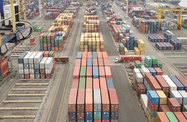Higher exports, supported by a robust industrial performance, took Vietnam’s GDP growth to a seven-year high in the first half of 2015, though trade imbalances and the risk of contagion from China remain a concern.
Vietnam’s GDP expanded by 6.3% year-on-year (y-o-y) in the first six months of 2015, according to official figures, exceeding earlier estimates of 6.1% and putting the economy on track to reach its 6.2% full-year growth target. Industry ranked among the top performers, with the index of industrial production recording a 9.6% y-o-y increase, according to a mid-year report issued by the General Statistics Office (GSO).
While industrial activity was up, the agriculture sector – one of Vietnam’s traditional powerhouses – was affected by drought. Its contribution to the economy slipped to 2.2% of GDP in the first six months of the year, down from 3.4% in 2014, according to Bui Quang Vinh, the minister of planning and investment.
Discussing the first-half results, Vinh acknowledged that while the general outlook remained positive, the decline in agriculture was a concern. “Agriculture is the pillar of the national economy, which creates jobs and ensures social security. It is a worrying problem that agricultural production is decreasing,” Vinh told local press in early July.
Balancing act
January to June has also seen a shift in Vietnam’s terms of trade, with imports exceeding exports for the first time in three years. While exports rose 9.3% y-o-y to $77.7bn, imports were up 17.7% at $81.5bn, resulting in a deficit of $3.8bn, GSO data showed.
Much of the trade gap was due to a 37.4% increase in machinery, equipment and components imports, which suggests higher levels of investment in plants and technology, as well as a 37.5% jump in imported electronic products, computers and related goods. Meanwhile, auto imports nearly doubled y-o-y to $2.95bn.
Although higher imports herald potential for growth in industry and construction, they remain a cause of concern for the government. Between January and June, the trade deficit reached 4.7% of export turnover, close to the annual limit of 5%. Vinh has called for measures to curb imports, warning on June 29 that a larger trade deficit could trigger an international payment imbalance and increase pressure on the dong-dollar exchange rate.
Cooling off period
Fears of a cooling Chinese economy will also be at the forefront in the coming months. In the first five months of the year, Vietnamese exports to China fell 1.2% y-o-y to $6.1bn, while imports rose 19.1% to $15.9bn. Weaker Chinese demand could see the trade balance become even more one-sided.
The dip in agricultural exports has reinforced this trend. Rice exports to China fell 22.6% y-o-y in the first six months of the year, according to the Ministry of Agriculture and Rural Development. A decline in exports of other agricultural products, such as coffee, tea and rubber, further contributed to the trade deficit.
Credit where credit is due
However, indicators suggest Vietnam has the capacity to sustain its economic pace in the second half of the year. Along with industrial expansion, demand for medium- and long-term credit is up, prompting banks to raise interest rates on deposits to boost liquidity and maintain exchange rate stability. In late June a number of leading lenders raised their short- and long-term deposit rates by between 0.1% and 0.5%, with rates for deposits of over one year at around 7%.
Nguyen Hoang Minh, deputy director of the Ho Chi Minh City office of the State Bank of Vietnam, told local press in late June that stronger demand for credit signalled renewed corporate investment in expansion.
Lending to the property market is also on the rise, with outstanding loans to the real estate sector up 10.9% y-o-y at the end of May, according to central bank data, more than double the 5% credit growth recorded for the banking sector as a whole over the period. This has the potential to carry through to both the construction and industrial sectors, spurring further growth later in the year and keeping GDP figures in line with government targets.

